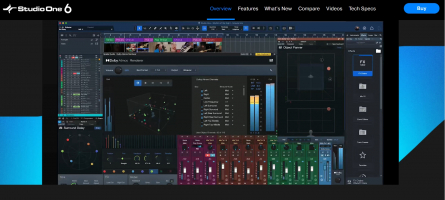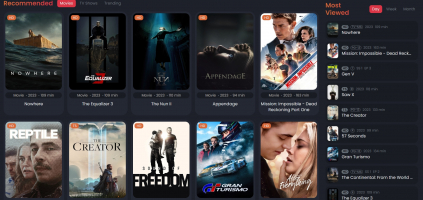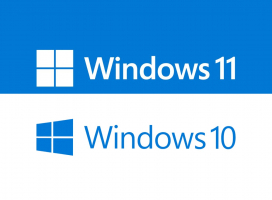Top 10 Best Docker Alternatives
Docker is another name-containing platform that helps create a virtual environment to manage and develop users' necessary applications. With widely used ... read more...alternatives rated by users and given positive comments. It will be a suggestion for you to refer to and learn more about popular Docker alternatives in this article.
-
Podman is an open-source containerization tool that is compatible with Docker and provides a Docker-compatible command-line interface. It is known for its rootless containers, which enhance security, and is a quality Docker alternative. Podman's command line interface is designed to be familiar to Docker users to better develop their applications. As far as I know, you can use Podman to build, run, and manage containers using the same scripts as in an actual Docker.
One of the standout features of Podman is its support for rootless containers. You are allowed to run virtual environments without waiting for root privileges and can also keep your device well-secured from the server system. Podman is based on Open Container Initiative (OCI) standards, making it compatible with other OCI-compliant tools and runtimes.When using Podman, my impression is that it is integrated with the system, allowing you to create and manage containers as a system service. If you run long scripts, it's useful to manage all those containers. Podman provides powerful network and volume management capabilities for containers, including support for custom networks, bridged networks, and various volume types.
Podman can build container images directly from Docker files or existing Docker images, making it easy to work with container images. Therefore, when using Podman it will docker alternatives for mac and docker alternatives for windows.
So, Podman is a flexible tool suitable for many containerization tasks, and its focus on security and compatibility with Docker makes it an attractive container Docker alternative. Especially for those who need advanced security features and are moving from Docker to another containerization solution.
Features:
- Create and manage containers, switch from Docker to Podman easily.
- Supports container groups.
Pros:
- Podman runs containers without root, making it more secure than Docker.
- Podman, thanks to its Pods feature, is a good starting point for Kubernetes.
- The syntax helps Docker users easily migrate to Podman.
Cons:
- Podman is not yet the ultimate solution for container management and requires additional accompanying tools to achieve full functionality.
- Podman still has many features behind Docker in terms of online support.
Founded: 2018
Headquarters: United States
Website: https://podman.io/
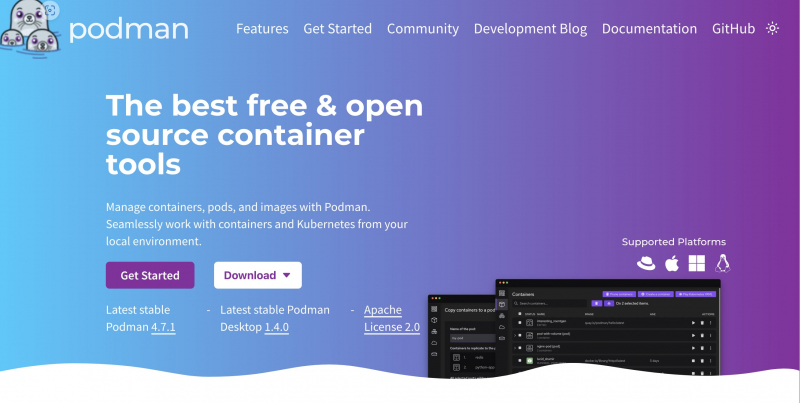
Screenshot via https://podman.io/ 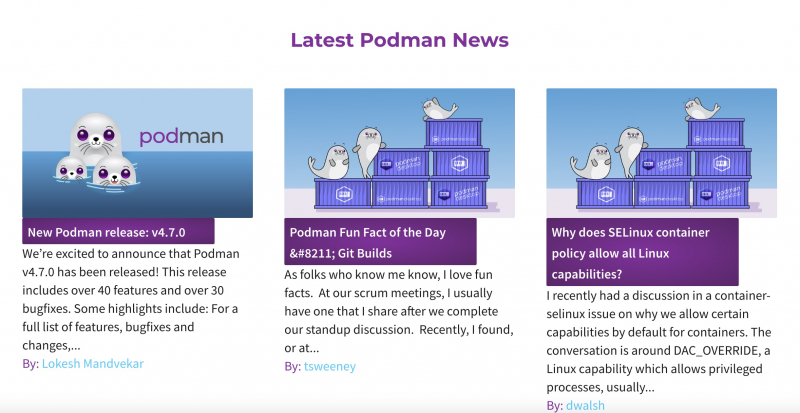
Screenshot via https://podman.io/ -
OpenVZ owned by Virtuozzo is a Linux-based packaging technology and has a platform similar to Docker in terms of features and functionality but with more improvements in terms of deploying applications as well as possible. OpenVZ provides simple command-line tools for managing containers, making it relatively easy to set up and maintain a containerized environment.
OpenVZ also allows you to create isolated environments, called containers on a physical server. OpenVZ is an operating system-level virtualization technology, all running applications have a kernel. The special thing about OpenVZ that I found beneficial when using it as a docker alternative is that it will create the application's working areas with memory, IP addresses, system libraries, applications, and file independence.
OpenVZ supports live migration of containers between physical hosts. This can be useful for load balancing or container migration without downtime. OpenVZ uses templates to create containers on the fly. Users can choose from a variety of pre-configured templates covering different Linux distributions and application stacks.
Using OpenVZ gave me simple command-line container management. In addition, OpenVZ also shares the server's kernel, so it can save more resources than traditional virtualization. It also has lower costs in terms of memory and CPU.Features:
- OpenVZ provides resource monitoring tools to track container resource usage.
- Enabling better resource allocation, performance optimization.
Pros:
- Easy to set up, use, and manage
- Has a user-friendly platform
- Maximum resources and good expansion
- There are significant savings in terms of memory and CPU usage
- Has high efficiency
Cons:
- No variety of manual options to showcase your operating system
- Not fully virtualized
- Not all modules can be accessed
Founded: 2005
Headquarters: Boston, Massachusetts, United States
Website: https://openvz.org/
Twitter: https://twitter.com/_openvz_
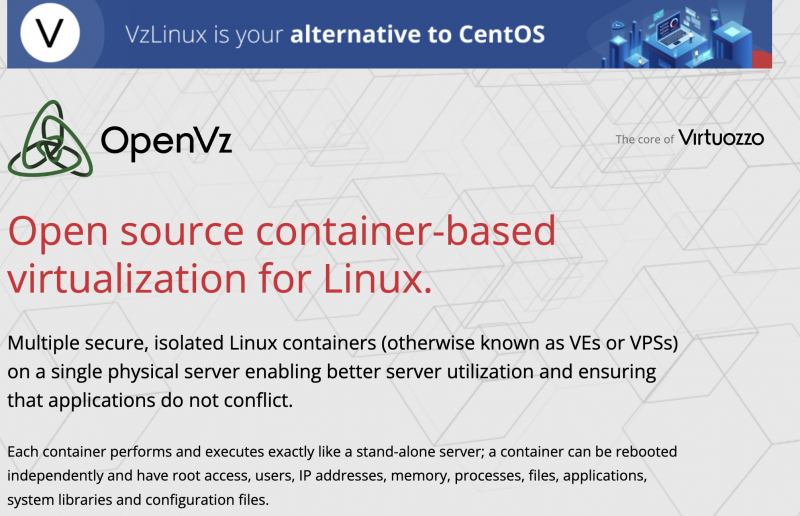
Screenshot via https://openvz.org/ 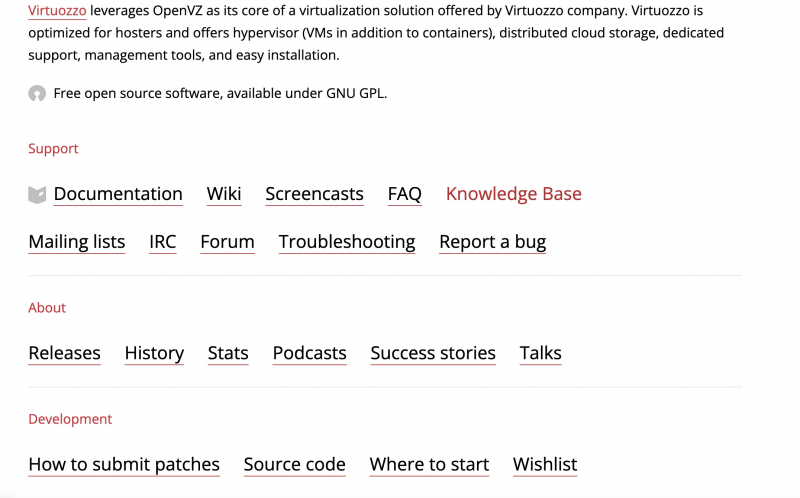
Screenshot via https://openvz.org/ -
VirtualBox is one of the best docker alternatives. It was launched in 2007, with the function of creating several virtual machines running on many different operating systems to create and run applications. VirtualBox itself has greater strengths than Docker in some functions such as smooth running and high security.
VirtualBox allows you to store and backup files and storage media across operating systems without requiring many rigorous steps like on Docker. VirtualBox offers more powerful features because virtual machines created on VirtualBox do not share the host OS kernel.
You will create independent virtual machines with their operating systems when using VirtualBox. This helps you ensure complete isolation between environments, preventing software and resource conflicts. Instead of using Docker images, you can use VirtualBox's standard virtual machine images or create your own virtual machine operating systems from scratch.
In summary, using VirtualBox as an alternative to Docker can be useful in some cases, but it is often more suitable for testing and developing applications on many different operating systems such as cross-platform support and environment—secure virtual environments or when absolute isolation between environments is necessary. In particular, docker alternatives for mac, and docker alternatives for windows.
Features:
- 3D Graphics Acceleration
- VirtualBox supports remote desktop functionality.
- VirtualBox offers more powerful features because virtual machines created on VirtualBox do not share the host OS kernel.
Pros:
- Multiple operating systems on the same computer.
- When the virtual box crashes, it has absolutely no effect on the server.
- Easy to use and install.
- Supports the latest hardware.
Cons:
- Less effective when used as an alternative to the docker.
- Depends on the server.
- Affected by server weaknesses.
Founded: 2007
Headquarters: Gauteng, NA-South Africa
Website: https://www.virtualbox.org/
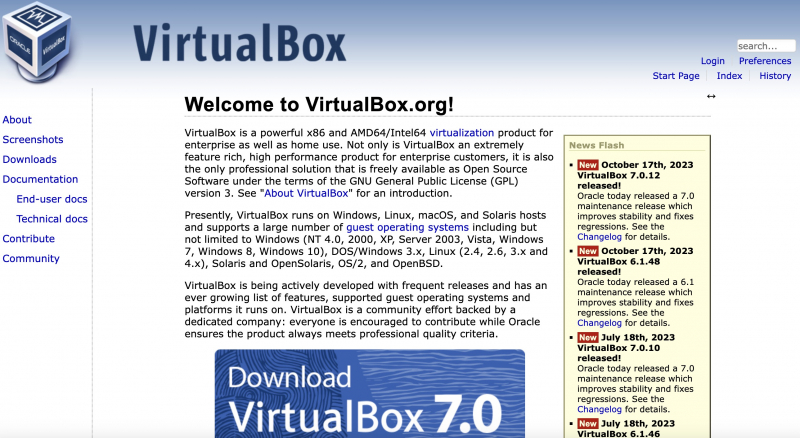
Screenshot via https://www.virtualbox.org/ 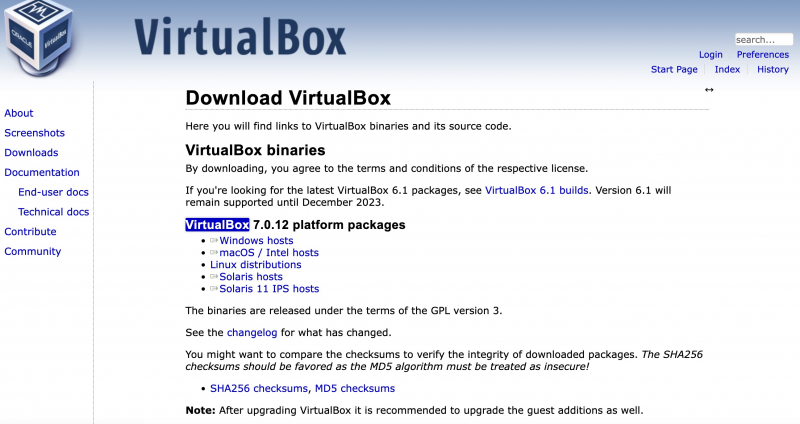
Screenshot via https://www.virtualbox.org/ -
Kubernetes, often abbreviated as K8s, is an open-source container orchestration platform that automates functions when managing containerized applications. Automation supports key functions for managing and developing applications.
Kubernetes automates container deployment and management, making it easier to run and scale containerized applications across a cluster of machines. Kubernetes is well suited to microservices architecture, allowing you to break down applications into smaller, easy-to-manage services, and then orchestrate their deployment and scaling.
Kubernetes has the additional feature of continuously monitoring the health of your application and restarting or rescheduling containers if they fail, improving the resiliency of your application. Kubernetes provides built-in load balancing to distribute network traffic across multiple instances of an application or service.
Kubernetes provides a way to securely manage sensitive information such as API keys and passwords using secrets. If you are running a lot of containerized applications, you can also use docker alternatives to Kubernetes.
Thus, Kubernetes has gained significant popularity due to its ability to simplify container orchestration, streamline the development process, and improve the scalability and reliability of containerized applications. There are already organizations and cloud providers stepping in to offer managed Kubernetes services that ease the operational burden of running and maintaining Kubernetes clusters as an alternative to Docker.Features:
- Kubernetes provides built-in load balancing.
- Provides a way to securely manage sensitive information such as API keys and passwords.
Pros:
- Kubernetes is designed for high availability.
- Kubernetes provides many networks and service integration options.
- Multi-cloud and multi-environment environments.
- Extensive community.
Cons:
- There is complexity in Kubernetes.
- Not suitable for simple applications.
Founded: 2014
Headquarters: San Francisco, California
Website: https://kubernetes.io/
YouTube: https://www.youtube.com/kubernetescommunity
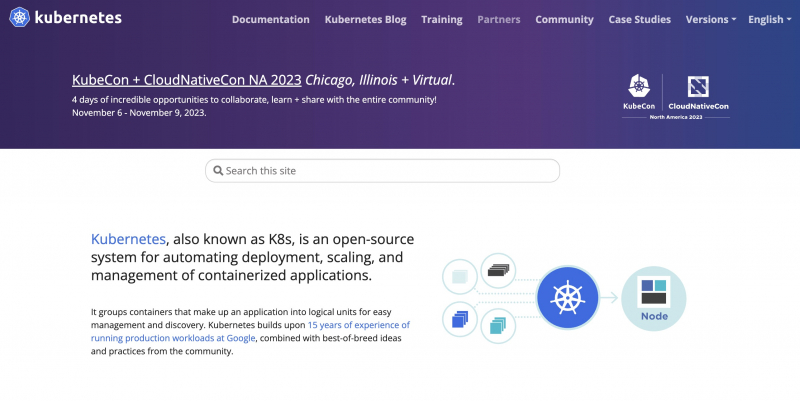
Screenshot via https://kubernetes.io/ 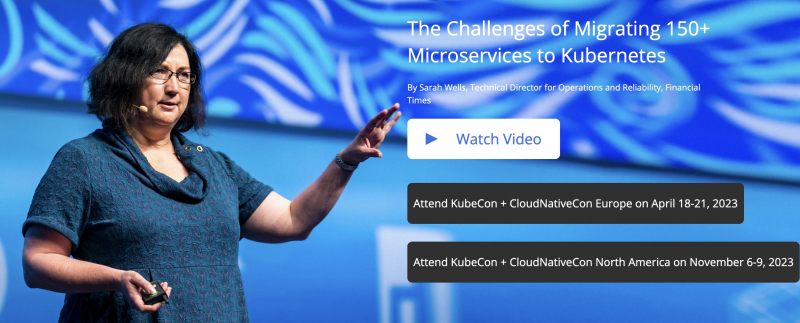
Screenshot via https://kubernetes.io/ -
LXC or Linux Containers is an operating system-level virtualization technology for Linux. It allows you to run multiple independent Linux operating systems on the same server. LXC is seen as a docker alternative to hypervisors and is used quite a bit in running data-intensive applications.
LXC containers are lightweight and resource efficient. Each container operates completely independently of other containers, creating isolation between applications and services. This helps ensure isolation and security between applications.
LXC is also part of the base of container runtimes like containers and Rocket, which help manage and run containers in Kubernetes environments. LXC provides management tools to create, launch, stop, delete, and manage containers. These tools help manage a large number of containers efficiently.
Overall, LXC is a flexible and powerful OS-level virtualization technology for Linux. It is suitable for many applications, especially when you need to integrate and manage Linux containers directly on a physical server.Features:
- Filesystem Isolation
- Resource Isolation
- Operating System-Level Virtualization
Pros:
- LXC shares the kernel operating system with the original server and optimizes performance.
- You can use Docker, Containerd, or other runtimes with LXC.
- LXC works on many versions of the Linux operating system.
Cons:
- There is no native integration for other systems such as Windows.
- LXC requires deep and advanced knowledge of the Linux system, which is disadvantageous for new users.
Founded: 2008
Website: https://linuxcontainers.org/
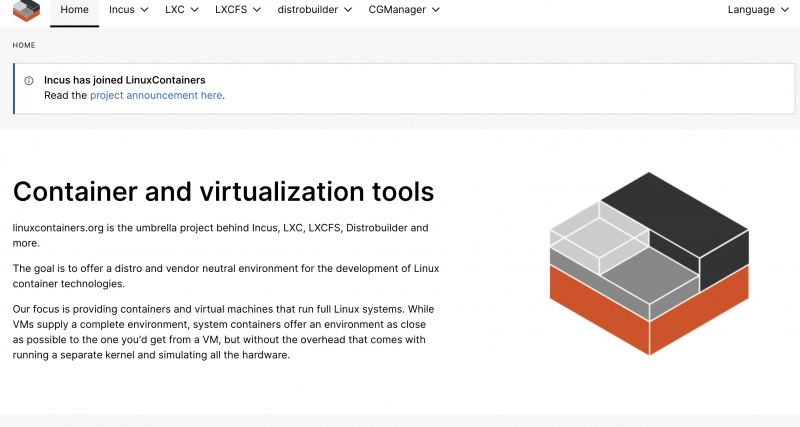
Screenshot via https://linuxcontainers.org/ 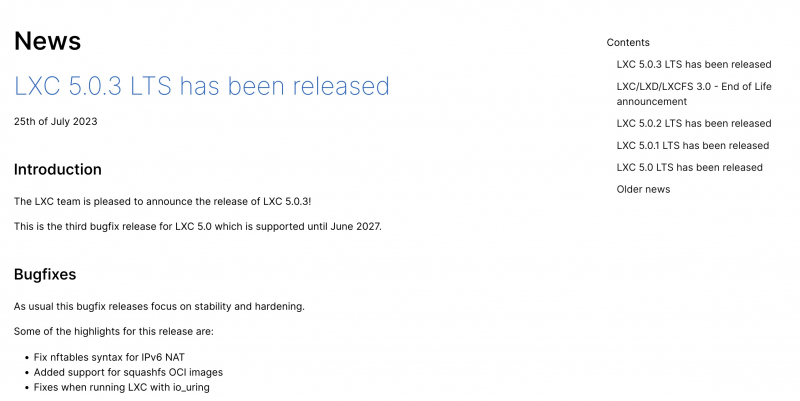
Screenshot via https://linuxcontainers.org/ -
Microsoft Azure Container Registry (ACR) is a service provided by Microsoft Azure for managing and storing container images on the Azure platform. It is considered one of the best alternatives to Docker. ACR comes with a Docker command-line interface for storing and managing container images.
Security is of utmost importance for Microsoft Azure. Therefore, the platform provides robust security policies to better manage containers, making it a trusted and powerful Docker alternative. ACR facilitates easy management of container clusters and enables developers to run and scale applications with ease using Docker CLI, Helm, Kubernetes, and Azure DevOps tools.Moreover, ACR is tightly integrated with other Azure services such as Azure Kubernetes Service (AKS), Azure Web Apps, and Azure Functions, which makes deploying and managing container applications easier on the Azure platform. ACR offers flexible pricing options based on your needs, including options that require pay-as-you-go.
In summary, Microsoft Azure Container Registry is an excellent alternative to Docker due to its robust features and user-friendly interface. Please visit the website to download the software.
Features:
- Integration with Azure Services
- ACR simplifies the management of container clusters and enables easy scaling and deployment of applications using Docker CLI, Helm, Kubernetes, and Azure DevOps.
Pros:
- Manage and store container images on the Azure platform.
- Microsoft Azure provides a robust virtualization platform compatible with Docker.
Cons:
- Requires a good understanding and strict requirements of Azure's access control system.
- Setting up and configuring ACR can be complex, especially for beginners.
Founded: 2008
Headquarters: United States
Website: https://azure.microsoft.com/en-us
Instagram: https://www.instagram.com/microsoftdeveloper/
X: https://twitter.com/Azure
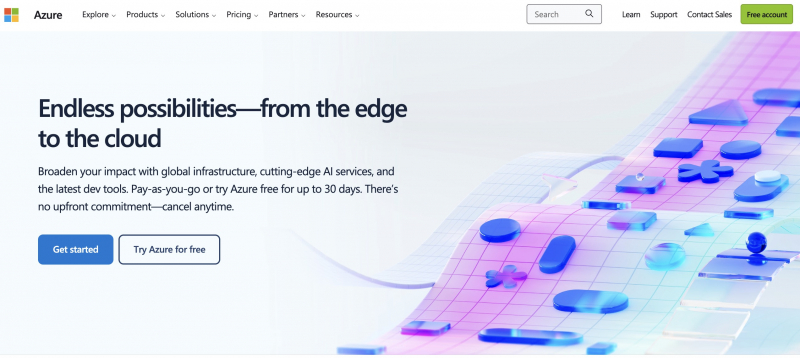
Screenshot via https://azure.microsoft.com/en-us 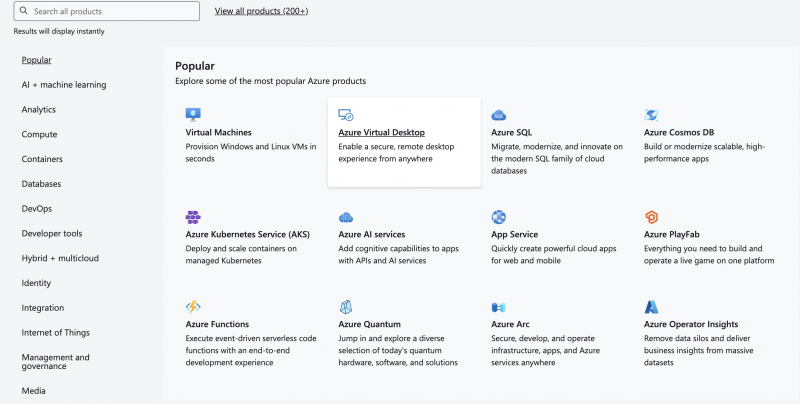
Screenshot via https://azure.microsoft.com/en-us -
Containerd is an open source Docker alternative that monitors and runs containers providing core functionality for container management. Containerd is designed to be a lightweight and efficient solution for running containers and is used by many different container platforms, including Docker.
Containerd focus on the runtime aspects of containers, allowing you to create and manage containers without the higher-level abstractions provided by tools like Docker. The container is extensible, allowing you to add custom plugins and extensions to tailor it to your specific needs. Containerd provides trust in use that is secure and provides features such as content trust and image signing to ensure the integrity and authenticity of container images.
Containerd is used as the container runtime for Kubernetes by container orchestration platforms such as containerd-shim, CRI-O, and others. Containerd's API gives you full control, making it easier to manage containers in virtual environments. Containerd is used as the core runtime component in Docker, handling core container operations, while the Docker CLI provides a user-friendly interface.
In summary, Containerd is an important component for container management and is commonly used in container runtimes and orchestration platforms. It provides basic container running capabilities while also providing scalability and compliance with open standards.Features:
- Designed to be a lightweight and efficient solution for running containers.
- Containerd's API gives you full control, making it easier to manage containers in virtual environments.
- Container images are verified through content trust and image signing.
Pros:
- Containerd is a platform that specializes in managing and executing containers.
- Docker provides some features for container execution and management, but it does not include some of the higher-level functionality than Containerd.
- Great Industry Adoption
Cons:
- Minimal Features
- The complexity of the CLI requires a lot from Containerd.
Founded: 2013
Website: https://containerd.io/
X: https://twitter.com/containerd
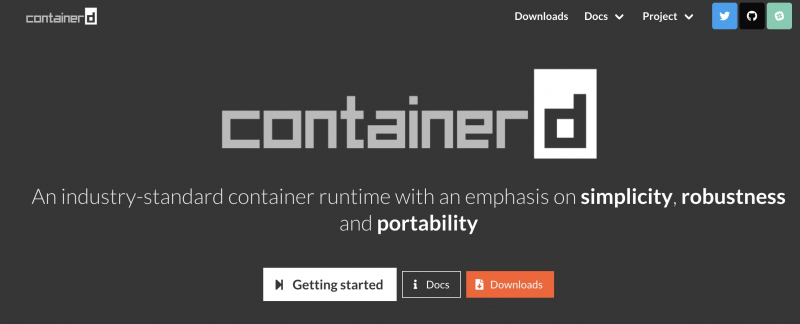
Screenshot via https://containerd.io/ 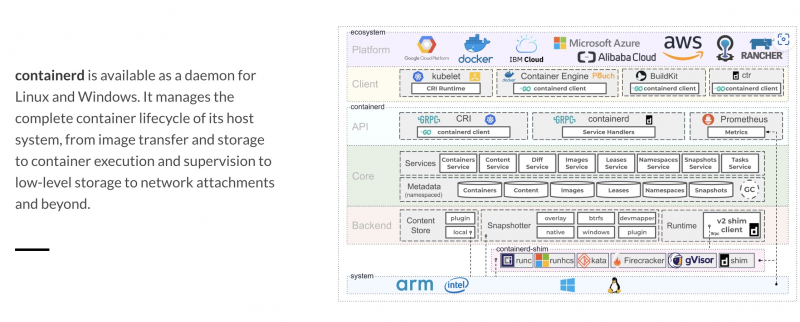
Screenshot via https://containerd.io/ -
Rancher is a good platform for finding Docker alternatives. It is open-source container management software that helps orchestrate containers, Kubernetes clusters, and cloud-native applications. Rancher is highly extensible and can integrate with many different container runtimes, including Docker, containers, and others.
It simplifies deployment, scaling, and management of containerized workloads in multi-cluster, multi-cloud environments. Typically, when administrators manage multiple clusters, it becomes difficult to manage such large groups of clusters, each with a unique configuration and access control settings.
Rancher simplifies the user-friendly interface, allowing for better management of Kubernetes, docker, and multiple container workloads. Rancher can manage and deploy applications across a variety of cloud providers, including Amazon Web Services (AWS), and Microsoft Azure.
Rancher provides backup and disaster recovery solutions for your Docker clusters and applications powered by Kubernetes.Features:
- Open-source container management software that helps orchestrate containers.
- Rancher is highly extensible and can integrate with many different container runtimes, including Docker, containers, and others.
Pros:
- Rancher has a way to back up and restore your Kubernetes applications.
- Rancher has good integration capabilities.
Cons:
- Managing a group manually can be quite challenging.
Founded: 2014
Headquarters: California, United States
Website: https://www.rancher.com/
YouTube: https://www.youtube.com/channel/UCh5Xtp82q8wjijP8npkVTBA
X: https://twitter.com/Rancher_Labs
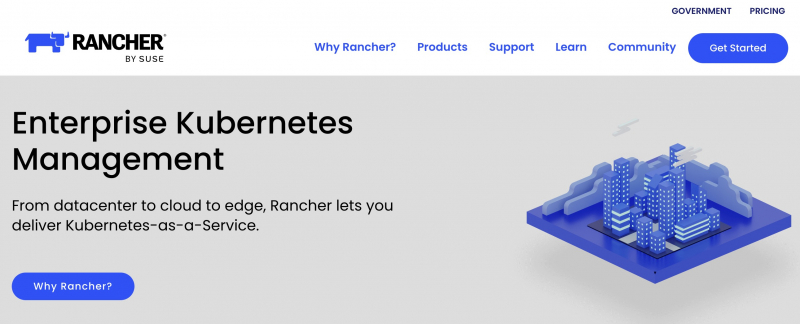
Screenshot via https://www.rancher.com/ 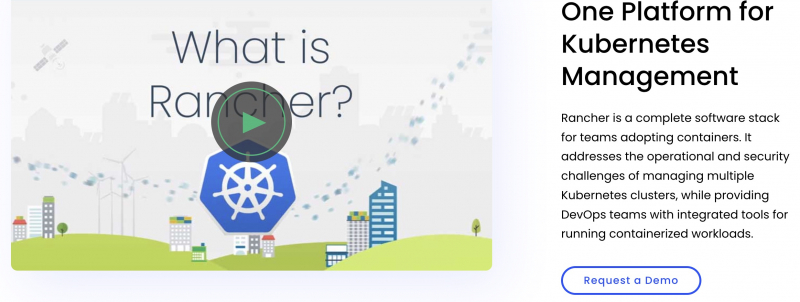
Screenshot via https://www.rancher.com/ -
Vagrant is a tool for managing virtual machine environments, allowing you to create, configure, and provision virtual machines of different configurations. It is also one of the best Docker alternatives that you need to know.
Vagrant is primarily used to manage and provision environments that contain applications running in virtual environments. Vaguely managed virtual machines often have more significant resource requirements because they run the entire operating system.
Vagrant provides strong isolation using separate virtual machines with independent operating systems. Vagrant is more suitable for creating full development environments with multiple VMs and doesn't have the isolation issue you might think with docker. It is often used for testing multi-tier applications with complex network setups.Of course, when using Vagrant, you are allowed to create image files on virtual machines and share them widely with the community without any difficulty.
Features:
- Allowing you to create, configure, and provision virtual machines of different configurations.
- Use for testing multi-tier applications with complex network setups.
Pros:
- Vagrant allows you to compartmentalize separate virtual machines for easier management.
- Vagrant environments are easy to share with team members or deployed on different servers.
Cons:
- Managing opaque Windows-based virtual machines can be more difficult due to licensing and compatibility issues.
Founded: 2010
Headquarters: California, United States
Website: https://www.vagrantup.com/
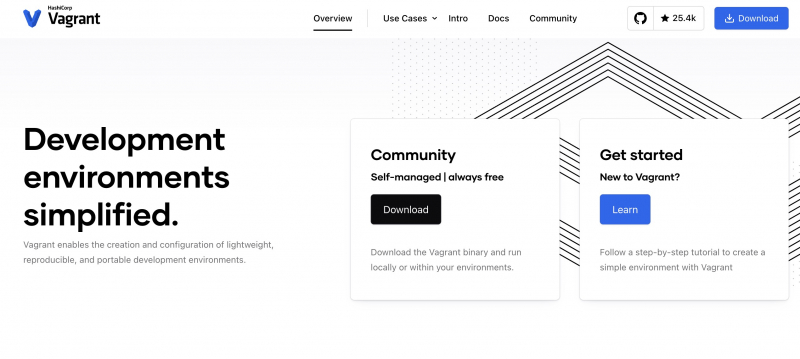
Screenshot via https://www.vagrantup.com/ 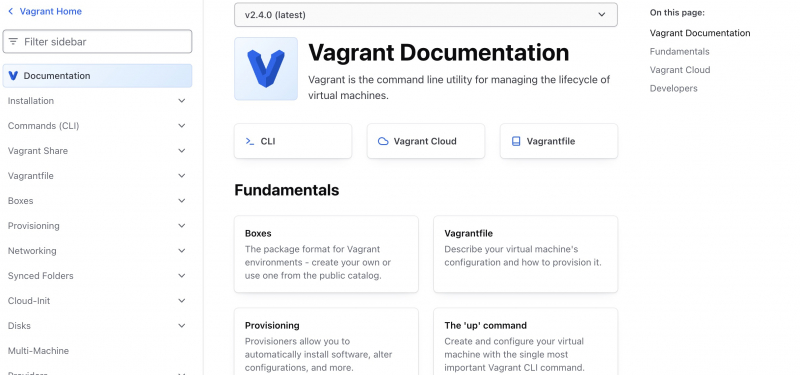
Screenshot via https://www.vagrantup.com/ -
ZeroVM is a platform that delivers lightweight virtualization technology. It has a unique design that executes an application quickly and securely in an isolated environment. ZeroVM is designed for lightweight, fast, and secure application execution. It creates isolated execution environments without using traditional virtual machines.
ZeroVM provides strong isolation between applications, ensuring that each application runs independently of the others. This enhances security and stability in multi-tenant cloud environments.
When you use ZeroVM, you will see many different programming languages run on applications without modification. If you need to process data quickly and in parallel, ZeroVM will be the right technology you should use. In short, ZeroVM is also the best tool to use as a docker alternative.Features:
- Lightweight virtualization allows the isolation and execution of applications in a sandboxed environment.
- ZeroVM was designed to be language-agnostic, allowing you to run code in various programming languages.
Pros:
- ZeroVM provides developers with an isolated virtual environment that is highly secure at the application level.
Cons:
- ZeroVM is not as portable as Docker containers.
Founded: 2014
Headquarters: San Antonio, Texas
Website: https://www.zerovm.org/
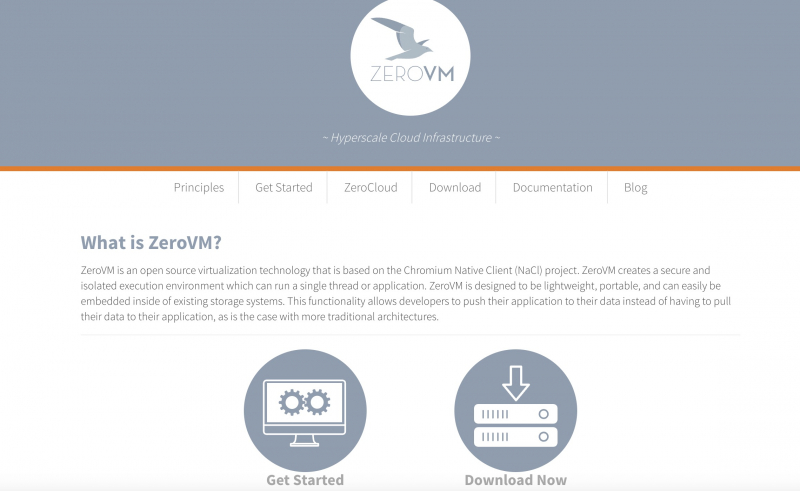
Screenshot via https://www.zerovm.org/ 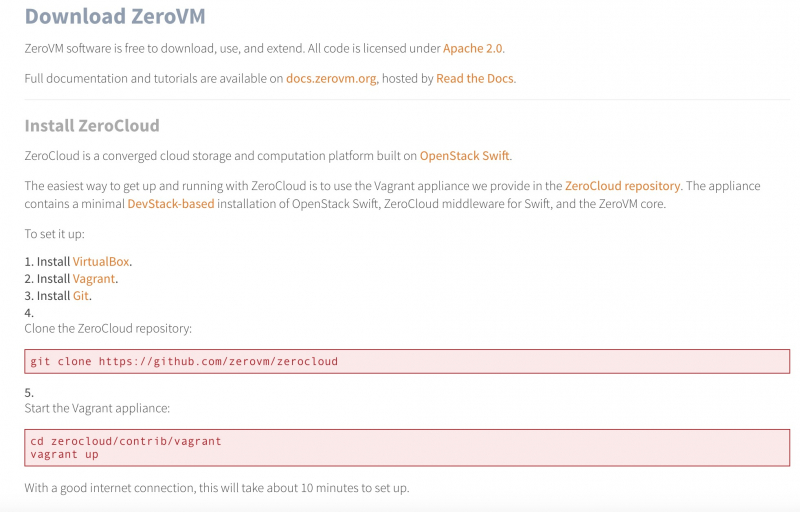
Screenshot via https://www.zerovm.org/



















